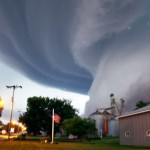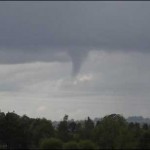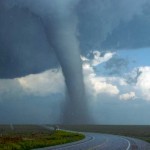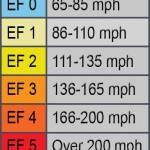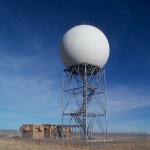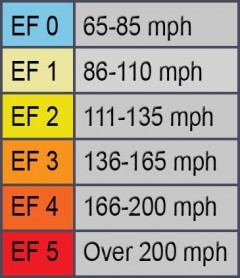 A tornado is measured and rated based on the Fujita tornado scale, which goes back to 1971. This rating is given based on how much damage the tornado has made to the vegetation and the structures made by humans. The scale goes from EF0 to EF5, from weak to extremely dangerous and with various wind speeds for each rating. Below you can see explanations for each tornado rating for the Enhanced Fujita Scale, which is an improvement over the old way of rating it, since it also takes into account the speed of the wind.
A tornado is measured and rated based on the Fujita tornado scale, which goes back to 1971. This rating is given based on how much damage the tornado has made to the vegetation and the structures made by humans. The scale goes from EF0 to EF5, from weak to extremely dangerous and with various wind speeds for each rating. Below you can see explanations for each tornado rating for the Enhanced Fujita Scale, which is an improvement over the old way of rating it, since it also takes into account the speed of the wind.
EF-0 is reserved for the weakest tornadoes, which have 65 to 85 mph wind speeds, which generally create only little damage, mostly because the branches and trees that will fall as a result. Any tornado that didn’t damage something is considered to be an EF-0.
EF-1 is given to the tornadoes which have 86 to 110 mph winds, with moderate damage as a result. Rooftop damage or overturned RVs are often a result of these tornadoes.
EF-2 is the category reserved for 111 to 135 mph tornadoes, which generally cause quite a bit of damage. Lifting a car or destroying a small structure is certainly possible with this type of tornado.
EF-3 is accompanied by winds with 136 to 165 mph speeds and they cause severe damage, being able to destroy homes that are well built, or to heavily damage big buildings.
EF-4 is a tornado which has a wind speed between 166 and 200 mph and they are considered devastating. A well built house can be leveled completely by such a tornado and a car can be thrown at great distances.
EF-5 is the highest level on the scale and a tornado of this type has wind speeds which are over 200 mph. Such a tornado can level entire neighborhoods. This situation calls for underground shelter no questions asked! Any structure above ground, even steel reinforced buildings may be leveled.


